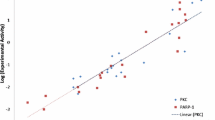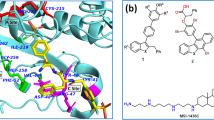Abstract
Tankyrases are the group of poly (ADP-ribosyl) polymerases (PARPs) which are the attractive targets in various therapeutic areas such as cancer, antiviral, diabetes, and hormonal imbalance. The selective nature of tankyrase 1 and 2 inhibitors has created solid base to get dual site binders as they bind to induced adenosine binding site and nicotinamide binding site resulting in dual site inhibition. The present work describes the cheminformatics approach to find potential lead molecules as tankyrases dual site inhibitors through pharmacophore model by utilizing protein-ligand interaction fingerprints (PLIF) approach. The constructed pharmacophore model was used in virtually screening of ZINC and Interbioscreen database. Top ten hit molecules of virtual screening were subjected to molecular docking in order gain insights of key interactions at the adenosine and nicotinamide binding sites. The top hits were subjected to molecular dynamics simulation studies to gain deeper insights into probable mechanism of inhibition and stability of the complex. The top hit ZINC12973507 showed all the features required in key interactions at the active site of tankyrases and this hit molecule can be further explored as a potential drug candidate for dual site inhibition of tankyrases.

Graphical abstract









Similar content being viewed by others
Data availability
The data used to support the findings of this study are available from the corresponding author upon request.
References
Morales JC, Li L, Fattah FJ, Dong Y, Bey EA, Patel M, Gao J, Boothman DA (2014) Review of poly (ADP-ribose) polymerase (PARP) mechanisms of action and rationale for targeting in cancer and other diseases. Crit Rev Eukaryot Gene Expr 24:15–28. https://doi.org/10.1615/CritRevEukaryotGeneExpr.2013006875
Haikarainen T, Krauss S, Lehtio L (2014) Tankyrases: structure, function and therapeutic implications in cancer. Curr Pharm Des 20:6472–6488. https://doi.org/10.2174/1381612820666140630101525
DaRosa PA, Klevit RE, Xu W (2018) Structural basis for tankyrase-RNF146 interaction reveals noncanonical tankyrase-binding motifs. Protein Sci 6:1057–1067. https://doi.org/10.1002/pro.3413
Voronkov A, Holsworth DD, Waaler J, Wilson SR, Ekblad B, Perdreau-Dahl H, Dinh H, Drewes G, Hopf C, Morth JP, Krauss S (2008) Structural basis and SAR for G007-LK, a lead stage 1,2,4-triazole based specific tankyrase 1/2 inhibitor. J Med Chem 56:3012–3023. https://doi.org/10.1021/jm4000566
Bregman H, Gunaydin H, Gu Y, Schneider S, Wilson C, DiMauro EF, Huang X (2013) Discovery of a class of novel tankyrase inhibitors that bind to both the nicotinamide pocket and the induced pocket. J Med Chem 14:1341–1345. https://doi.org/10.1021/jm301607v
Nkizinkiko Y, Desantis J, Koivunen J, Haikarainen T, Murthy S, Sancineto L, Massari S, Ianni F, Obaji E, Loza MI, Pihlajaniemi T, Brea J, Tabarrini O, Lehtio L (2018) 2-Phenylquinazolinones as dual-activity tankyrase-kinase inhibitors. Sci Rep 8:1680–1690. https://doi.org/10.1038/s41598-018-19872-3
Gunaydin H, Gu Y, Huang X (2012) Novel binding mode of a potent and selective tankyrase inhibitor. PLoS One 7:e33740–e33746. https://doi.org/10.1371/journal.pone.0033740
Shultz MD, Kirby CA, Stams T, Chin DN, Blank J, Charlat O, Cheng H, Cheung A, Cong F, Feng Y, Fortin PD, Hood T, Tyagi V, Xu X, Zhang B, Shao W (2012) [1,2,4]triazol-3-ylsulfanylmethyl-3-phenyl-[1,2,4]oxadiazoles: antagonists of the Wnt pathway that inhibit tankyrases 1 and 2 via novel adenosine pocket binding. J Med Chem 55:1127–1136. https://doi.org/10.1021/jm2011222
Haikarainen T, Narwal M, Joensuu MP, Lehtio L (2013) Evaluation and structural basis for the inhibition of tankyrases by PARP inhibitors. Med Chem Lett 5:18–22. https://doi.org/10.1021/ml400292s
Menear KA, Adcock C, Boulter R, Cockcroft XL, Copsey L, Cranston A, Dillon KJ, Drzewiecki J, Garman S, Gomez S, Javaid H, Kerrigan F, Knights C, Lau A, Loh Jr VM, Matthews IT, Moore S, O’Connor MJ, Smith GC, Martin NM (2008) 4-[3-(4-cyclopropanecarbonylpiperazine-1-carbonyl)-4-fluorobenzyl]-2H-phthalazin-1-one: a novel bioavailable inhibitor of poly(ADP-ribose) polymerase-1. J Med Chem 51:6581–6591. https://doi.org/10.1021/jm8001263
Hua Z, Bregman H, Buchanan JL, Chakka N, Guzman-Perez A, Gunaydin H, Huang X, Gu Y, Berry V, Liu J, Teffera Y, Huang L, Egge B, Emkey R, Mullady EL, Schneider S, Andrews PS, Acquaviva L, Dovey J, Mishra A, Newcomb J, Saffran D, Serafino R, Strathdee CA, Turci SM, Stanton M, Wilson C, Dimauro EF (2013) Development of novel dual binders as potent, selective, and orally bioavailable tankyrase inhibitors. J Med Chem 56:10003–10015. https://doi.org/10.1021/jm401317z
Huang H, Guzman-Perez A, Acquaviva L, Berry V, Bregman H, Dovey J, Gunaydin H, Huang X, Huang L, Saffran D, Serafino R (2013) Structure-based design of potent and selective ck1γ inhibitors. Med Chem Lett 41218-1223. https://doi.org/10.1021/ml300278f
InterBioScreen database. https://www.ibscreen.com/, (accessed August 2018)
Irwin JJ, Sterling T, Mysinger MM, Bolstad ES, Coleman RG (2012) ZINC: a free tool to discover chemistry for biology. J Chem Inf Model 521757–1768. https://doi.org/10.1021/ci3001277
Vilar S, Cozza G, Moro S (2008) Medicinal chemistry and the molecular operating environment (MOE): application of QSAR and molecular docking to drug discovery. Curr Top Med Chem:81555–81572. https://doi.org/10.2174/156802608786786624
Da C, Kireev D (2014) Structural protein–ligand interaction fingerprints (SPLIF) for structure-based virtual screening: method and benchmark study. J Chem Inf Model 542555–2561. https://doi.org/10.1021/ci500319f
Patil SR, Asrondkar A, Patil V, Sangshetti JN, Khan FA, Damale MG, Patil RH, Bobade AS, Shinde DB (2017) Antileishmanial potential of fused 5-(pyrazin-2-yl)-4H-1,2,4-triazole-3-thiols: synthesis, biological evaluations and computational studies. Bioorg Med Chem Lett 273845-3850. https://doi.org/10.1016/j.bmcl.2017.06.053
VLifeMDS V (2012) VLife sciences technologies Pvt. Ltd Pune, India http://www.vlifesciences.com/ (accessed 20 September 2017)
Van Der Spoel D D, Lindahl E, Hess B, Groenhof G, Mark AE, Berendsen HJ (2005) GROMACS: fast, flexible, and free. J Comput Chem 26:1701–1718. https://doi.org/10.1002/jcc.20291
Huang J, Rauscher S, Nawrocki G, Ran T, Feig M, de Groot BL, Grubmüller H, MacKerell Jr AD (2016) CHARMM36m: an improved force field for folded and intrinsically disordered proteins. Nat Methods 14:71–73. https://doi.org/10.1038/nmeth.4067
Vanommeslaeghe K, Hatcher E, Acharya C, Kundu S, Zhong S, Shim J, Darian E, Guvench O, Lopes P, Vorobyov I, MacKerell Jr AD (2010) CHARMM general force field: a force field for drug-like molecules compatible with the CHARMM all-atom additive biological force fields. J Comput Chem 31671-690. https://doi.org/10.1002/jcc.21367
Hess B, Bekker H, Berendsen HJ, Fraaije JG (2009) LINCS: a linear constraint solver for molecular simulations. J Comput Chem 18:1463–1472. https://doi.org/10.1002/(SICI)1096-987X(199709)18:12<1463::AID-JCC4>3.0.CO;2-H
York DM (1993) The effect of long-range electrostatic interactions in simulations of macromolecular crystals: a comparison of the Ewald and truncated list methods. J Chem Phys 998345-8348. https://doi.org/10.1063/1.465608
Lagorce D, Sperandio O, Galons H, Miteva MA, Villoutreix BO (2008) FAF-drugs2: free ADME/tox filtering tool to assist drug discovery and chemical biology projects. BMC Bioinformatics 9:396–405. https://doi.org/10.1186/1471-2105-9-396
Vyas V, Jain A, Jain A, Gupta A (2008) Virtual screening: a fast tool for drug design. Sci Pharm 76:333–360. https://doi.org/10.3797/scipharm.0803-03
Acknowledgments
Authors are thankful to Dr. Zahid Zaheer, Principal, Y.B. Chavan College of Pharmacy, and Dr. Rafiq Zakaria Campus, Aurangabad 431001 (M.S.), India, for providing the laboratory facility. The authors SAA, HMA and AAA would like to extend their sincere appreciation to the Deanship of Scientific Research at King Saud University for funding through the Research Group Project No. RG-1439-010.
Funding
The authors SAA, HMA, and AAA received financial support from the Deanship of Scientific Research at King Saud University through the Research Group Project No. RG-1439-010.
Author information
Authors and Affiliations
Corresponding authors
Ethics declarations
Conflict of interest
The authors declare that they have no conflict of interest.
Additional information
Publisher’s note
Springer Nature remains neutral with regard to jurisdictional claims in published maps and institutional affiliations.
Electronic supplementary material
ESM 1
(DOC 361 kb)
Rights and permissions
About this article
Cite this article
Damale, M.G., Patil, R., Ansari, S.A. et al. Identification of dual site inhibitors of tankyrase through virtual screening of protein-ligand interaction fingerprint (PLIF)–derived pharmacophore models, molecular dynamics, and ADMET studies. Struct Chem 31, 769–779 (2020). https://doi.org/10.1007/s11224-019-01467-x
Received:
Accepted:
Published:
Issue Date:
DOI: https://doi.org/10.1007/s11224-019-01467-x




